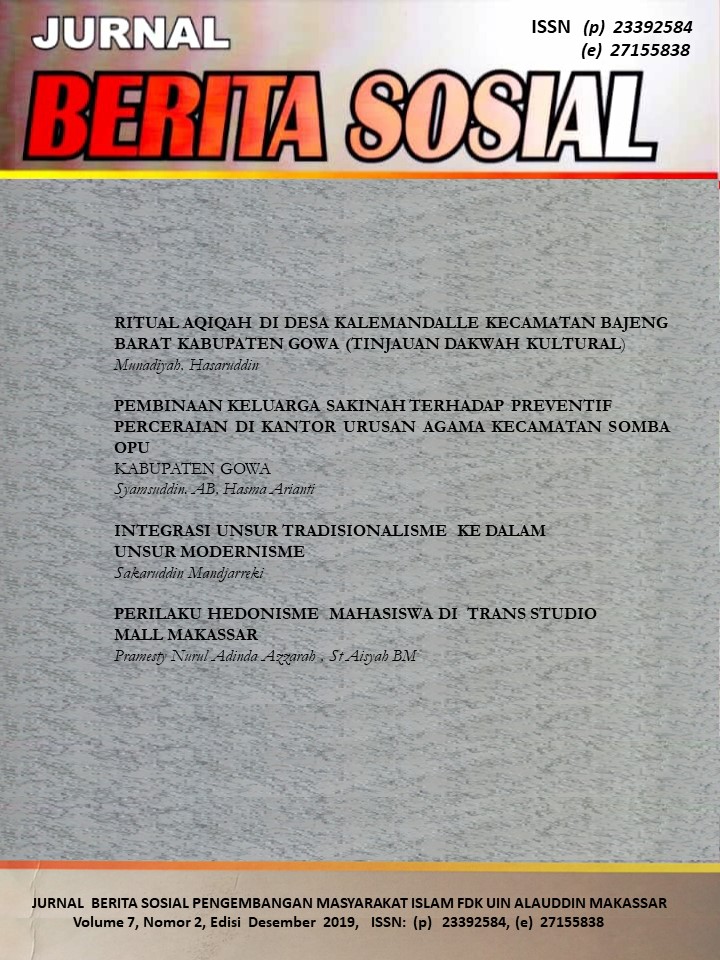INTEGRASI UNSUR TRADISIONALISME KE DALAM UNSUR MODERNISME
Abstract
In a sociological perspective, individuals are always in an ambivalent, duality, and inconsistent position. The pounding wave of globalization that triggered and spurred the spirit of modernization, has simultaneously positioned and even led individuals to the altar of dualism, namely deifying the side of modernity through a set of modern behavior but at the same time worshiping the essence of traditionalism by being reluctant to abandon its cultural and locality aspects. This behavior seems to confirm that between the past and the present time, of course, can be compromised, or more precisely it can be integrated in a format of life that is adaptive and flexible to both periods; traditional and modern.Tradition is the pinnacle of human intellectuality that was previously codified, constructed, implemented, and rooted through behavioral patterns to technology to support its collective life. The innovation that we know today in its more complex and sophisticated form is actually a reproduction of past traditions with a simple pattern.References
Betty R, Scharf. 2004. “The Sociological Study of Religion”. Terjemah: Machnun Husein. Sosiologi Agama. Jakarta: Prenada Media.
Bustanuddin, Agus. 2006. Agama dalam Kehidupan Manusia: Pengantar Antropologi Agama. Jakarta: Rajawali Perss.
Sztompka, Piotr. 2010. Sosiologi Perubahan Sosial. Jakarta: Prenada.
Abdullah, T. (1982), Agama, Etos Kerja, dan Perkembangan Ekonomi (ed). Jakarta: LP3ES.
Brubaker, R. (1984), The Limits of Rationality: An Essay on the Social and Moral Thought of Max Weber. London: George Allen and Unwin.
Calhoun, C. (2002), Classical Sociological Theory (ed). Massacusetts: Blackwell Published Ltd.
Durkheim, E. (1947), The Elementary Forms of Religious Life. New York: Free Press.
_________, (1964), The Division of Labour in Society. New York: Free Press.
_________, (1966), Suicide. New York: Free Press.
Gerth, H. & Mills, C.W. (1958), From Max Weber: Essays in Sociology. New York: Oxford University Press.
Halevy E.E. (1964), Social Change: Source, Pattern, and Consequences (ed). New York: Basic Books Inc. Publishers.
Johnson, D.P. (1986), Teori Sosiologi Klasik dan Modern, terjemahan Robert M.Z. Lawang dari judul asli “Sociological Theory Classical Founders and Contemporary Perspectives” (John Wiley & Sons Inc.). Jakarta: Penerbit P.T. Gramedia.
Marx, K. (1891), Capital, Vol. 2. New York: Vintage Books.
Morris, B. (2003), Antropologi Agama: Kritik Teori-Agama Kontemporer. Yogyakarta: AK Group.
Northcott, M.S. (1999), “Pendekatan Sosiologis dalam Studi Agama”, dalam Peter Connolly (ed.) Aneka Pendekatan Studi Agama, terjemahan dari judul asli Approaches to the Study of Religion. Yogyakarta: LKIS.
Ritzer, G. & Goodman, D.J. (2003), Teori Sosiologi Modern, terjemahan Alimandan dari judul asli “Modern Sociological Theory” (McGraw-Hill). Jakarta: Kencana-Prenada Media.
Salim, A. (2002), Perubahan Sosial: Sketsa Teori dan Refleksi Metodologi. Yogyakarta: Tiara Wacana.
Turner, B.S. (1982), “Islam, Kapitalisme, dan Tesis Weber”, dalam Taufik Abdullah (ed) Agama, Etos Kerja, dan Perkembangan Ekonomi. Jakarta: LP3ES.
Worsley, P. (2002), Marx and Marxian. London & New York: Routledge.
* Tugas Ujian Akhir Semester Program Doktoral (S-3) Departemen Antropologi dalam Mata Kuliah-Wajib Teori Sosiologi Klasik Program Pascasarjana Sosiologi FISIP UI, 7 Januari 2005.

